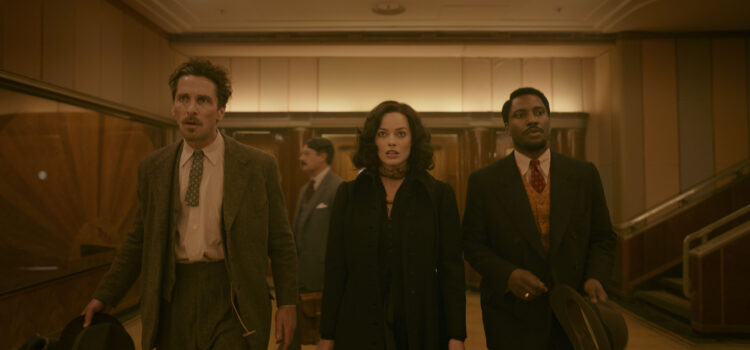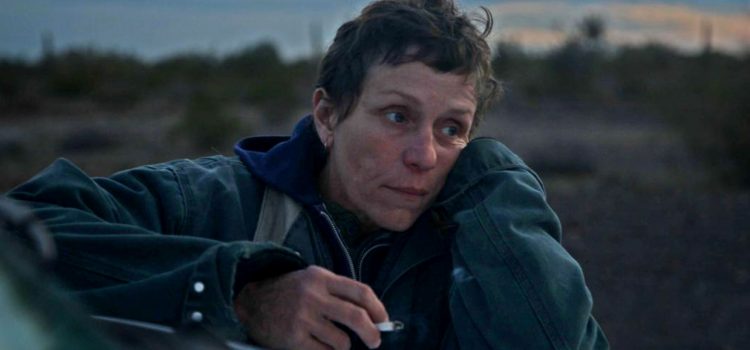By Lynn Venhaus
With its genre mash-up of science fiction, horror, action-adventure and romance, the most surprising of all is that the romance is the most satisfying aspect of “The Gorge.” And that’s because of the sparks flying between charismatic co-stars Anya Taylor-Joy and Miles Teller.
While this mysterious thriller has intriguing menacing elements, it does take a while to get going, but once the creature danger plotline is revealed, it doesn’t take a biochemist to explain it all to us (although that does help) – so then what follows is entirely predictable and borders on the ridiculous at times.
But the pair’s coupling is worth sticking out the extra-long runtime of 2 hours, 7 minutes, because these lost souls are clearly meant to be together. As two lone wolves, they discover not only do they have their line of work in common, but so much more. Tenderly, though, they bond through poetry and music, which is a sweet, thoughtful touch.
Both are hired guns – she’s a Lithuanian assassin whose dad was a KGB agent, and he’s a former U.S. Marine who takes on sniper assignments, used to a solitary existence. They’ve accepted a vague year-long assignment to be guards at an undisclosed location.
They are told they are protecting the world from the present evil in this misty gorge, with eerie noises and a foreboding terrain. The enemy is unseen, but it’s only a matter of time until the threat is disclosed.

Teller’s Levi Kane is in the West Tower while Taylor-Joy’s Drasa is in the East Tower, super-secret representatives of a government pact made during the Cold War, during the tail end of World War II.
Levi, a reader, discovers a wall inscribed with sayings from all the previous guards, hidden behind a bookcase. He’s given a training lesson from his British counterpart who’s about to return to civilization after 365 days. As JD, Sope Dirisu alludes to the “Hollow Men,” a reference to the T.S. Eliot poem that Levi is familiar with, so that’s a tipoff.
Levi is told not to have contact with ‘the other side,’ although it’s unclear why not. The watchtower is self-sufficient with a garden, rainwater system, solar power, and he must perform a radio check every 30 days. Lots o’ firepower for protection as well.
Drasa may not have gotten the same memo, so she fires the first shot – they begin writing messages to each other, visible in their panoramic windows. It doesn’t take long before they’re playing long-distance chess and feeling a strong connection. What develops is fun and joyful, because it all makes sense in a swashbuckling scenario.
The screenplay by Zach Dean, while clever, has limitations because once we figure out who the real threat is, we’re faced with an onslaught of increasingly icky gross ‘things’ that crawl, some form of zombified human-plant-insect hybrids. They are relentless in trying to climb the steep walls of their ‘hell.”

Among other higher profile projects, Dean wrote one of my favorite guilty pleasures, “Deadfall,” so I admire his intentions. Yet, he did write “Fast X,” not chimps, which is what I suspected.
After repeated gnarly attacks, it doesn’t take a nuclear physicist to figure out that some sort of chemical warfare experiments have gone wrong (but of course, there is more to that discovery).
Our heroes now must team up for their survival, and the gauntlet is a disgusting maze of natural and man-made disasters. Director Scott Derrickson, who has crafted some well-received horror movies, including “The Black Phone,” and the mega-blockbuster “Doctor Strange,” has laid out a booby-trapped road map that benefits from cinematographer Dan Laustsen, who is known primarily for his work with Guillermo del Toro and “John Wick” chapters 2-4.
Lausten makes the environment a terrifying living, breathing world for this resourceful and smart couple to navigate, with plenty of tension and threats of bodily harm. Their final attempt to escape is quite an inventive piece of derring-do.
The score is a dandy spooky synth-driven composition by Trent Reznor and Atticus Ross that adds to the creepy atmosphere, and Drasa’s musical taste unearths some alt-rock favorites like the Yeah Yeah Yeah’s “Spitting Off the Edge of the World.”
This is best to enjoy with as few expectations as possible. Come for the romance and stay for the thrills.

“The Gorge” is an action-adventure sci-fi horror thriller romance directed by Scott Derrickson and starring Miles Teller and Anya Taylor-Joy. Rated PG-13 for intense sequences of violence and action, brief strong language, some suggestive material and thematic elements, its run time is 2 hours, 7 minutes. It began streaming on Apple TV+ on Feb. 14. Lynn’s Grade: B.

Lynn (Zipfel) Venhaus has had a continuous byline in St. Louis metro region publications since 1978. She writes features and news for Belleville News-Democrat and contributes to St. Louis magazine and other publications.
She is a Rotten Tomatoes-approved film critic, currently reviews films for Webster-Kirkwood Times and KTRS Radio, covers entertainment for PopLifeSTL.com and co-hosts podcast PopLifeSTL.com…Presents.
She is a member of Critics Choice Association, where she serves on the women’s and marketing committees; Alliance of Women Film Journalists; and on the board of the St. Louis Film Critics Association. She is a founding and board member of the St. Louis Theater Circle.
She is retired from teaching journalism/media as an adjunct college instructor.
















